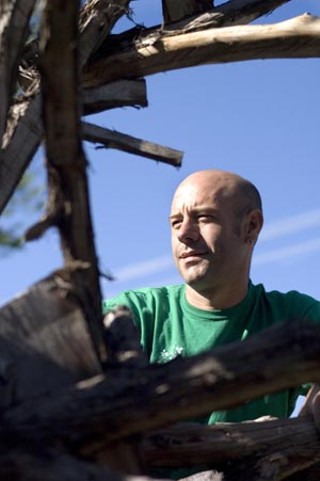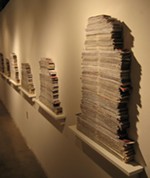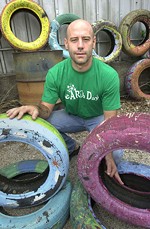Growing Pains
Rapidly expanding Austin Green Art works to sustain its mission and identity
By Nikki Moore, Fri., April 18, 2008
Last spring, I met Austin Green Art founder Randy Jewart for a one-on-one conversation about a man, his work, his mission in Austin, and the people ready to help and build with him. (See "Green on the Go," May 25, 2007.) Eleven months later, as Austin Green Art is applying two major foundation grants toward organizational planning to account for growth and growth potential, I was met by Jewart plus Matt Presley and Elizabeth Moliter, chief executive officer and sales manager, respectively, of Agave's development corporation, Austin Urban Digs; three-year Austin Green Art project manager Robby Lee; and new member and Austin entrepreneur Ryan Battle. Over dinner at Curra's, we discussed Austin Green Art's growth, growing pains, and the foundations for its own sustainability.
Austin Chronicle: First, congratulations on the new grants from Austin Community Foundation and the Shield-Ayres Foundation. Austin Green Art is also working on several exciting projects with the Domain and Agave developments. I imagine this is a time of real growth and learning for the organization.
Randy Jewart: What I've learned coming into the mix of these projects is that regardless of what your intentions are as a participant in the development process, whether you are an architect, developer, interior designer ... there are mechanics in place that make it very difficult to do anything outside of those mechanics. There are real legal issues. For example, right now we are trying to work out the legal issues to allow Austin Green Art, a nonprofit, to own spaces within the Agave development. From what seems like a great idea – the artists will own the garden and do sculpture and programming – there are all these issues like taxes: Who is going to pay the taxes on space dedicated to a nonprofit? And where does funding for maintenance come from after the developer sells off his pieces of the development? If you build a golf course, these things are straightforward because you've got revenue, but [what] if you build something that isn't revenue-driven?
With the help of attorneys from UT legal aid, we are working on creating a for-profit subsidiary. Because arguably, there isn't a community-driven enterprise that is not necessarily a charitable enterprise – but to be able to be active in each direction, we need both AGA Inc. and AGA nonprofit. What we're trying to argue with the attorneys is that whether we're getting paid to make this work or whether it is charitable, the goal is to be making art in this unique kind of way that drives a message through each object and whoever gets to see it.
Matt Presley: With Agave, I think there is a good match here in goals and hopes. In theory, there are possibilities where people could be paying their homeowner association dues and contributing to a nonprofit all at once.
AC: Matt, tell me about your role at Agave and with Austin Urban Digs.
Presley: My time is spent on the consulting/feasibility side, on how you link design into business. I advise on design and consumer impact. Design and economy aren't totally separate things, so how do we create a situation where developers can understand the impact of design decisions? Most of this gets left out, because many of these things – art, design choices – don't have an established dollar value attached to them. My job is to help by looking at what Ryan [Battle] is calling intangibles, to see how you can impact and improve the development and quality of life but also how it impacts the economy and the city. We help create a draw for culturally driven residents. Getting their capital is such a small part of this; getting their creative input and investment in our developments is what we really want to build.
Ryan Battle: There are great similarities between how intangibles like creativity, sustainability, and community relate to both the entrepreneurial process and the artistic process. And as our society changes, the value of these intangibles also changes. For an eco-entrepreneur, these societal shifts present opportunities to look at how we do things and mold intangibles together to derive new forms of value, where value is not necessarily expressed in a dollar figure. What draws my involvement in AGA is that it mashes together a number of intangible ideas – artistic expression, reuse, powers of family and community, goodwill to earth – and creates value for its participants and earth. In my current project, I'm looking at a similar set of intangibles and applying them to the work/life balance of Austin's amazing independent workforce. Looking to create greater value out of their time and dollar by incorporating large doses of local artistic expression and smarter utilization of physical space in our urban core. The mashing of these ideas 10, even five years ago would have garnered you a blank stare. Today, that blank stare is an interested head nod. From stare to nod, that's progress, particularly when it creates opportunity for the arts and benefit to the earth.
AC: So Randy, as your project spans grow to include both local gardens and community park space, schoolroom projects, and collaborations with national organizations like Forest Ethics, do you think the organization is changing fundamentally to account for this growth? In other words, how do you maintain AGA's focus in the midst of this expansion?
Jewart: When we started Austin Green Art, we were thinking Austin is a community that cares about environmental things, and as artists, we can help the public understand art in general by giving it this green entry point. Steel-scrap art sculpture, for example, doesn't have anything to do with environmental issues, but fundamentally it is a reuse project, and in telling that story, we can help people appreciate it as reuse, as something approachable.

Now the goal is to show up without art but with a service, to say, "What are you trying to do at Agave or at the Hill Country Conservancy, and how can we become inspired to make art by what it is that you are doing?" Every artist chooses their muse, and we choose the muse of collaboration; then we decide what we're going to make from that setting. On a nonprofit level, our big event is Clean Sweep, where we go and clean up the rivers and creeks; then we have this big party, one day with thousands of people, where we make art to help tell the story of why this cleanup is important. Instead of us standing at a microphone talking about how great it is to clean up a creek, everybody is working together to make a giant fish out of what we cleaned out. It becomes community development. That is what Austin Green Art's mission was and still is: to create this thing that gets everybody moving and talking and drawing conclusions about these issues they are participating in. The whole community comes out a notch higher than it would have been without it in terms of relationships, in terms of discourse about things that are very complicated.
AC: Austin Green Art not only challenges the traditional mechanisms for development and organization, but it also calls for a very different kind of artist, one whose ego or self-conception as the genius artist takes a back seat to the larger goals of sustainability and equal collaboration. Is this difficult to maintain as Austin Green Art expands from a one- to three-man show to a larger collaborative?
Jewart: That is what we are in the thick of, for sure. Ideally, from an artistic and an organizational standpoint, we are looking for the right artist who can do the right job ... not even necessarily that we are that right artist. There is a fundamental belief in us that everybody is an artist, and we're ready to have everybody's ideas and input, and tied to that is a tension against a culture of specialization, where I am an artist, and you're an engineer, or you're a designer. So we are working on each project to build positive adrenaline as we all change and participate and learn about our capabilities.
Organizationally, we are just looking for people who share the core values and are willing to take the ball and run with it in lots of different directions, rather than saying, "We're going this way." It's a challenge, but this connects with the forefront of the environmental activism right now. Paul Hawken's new book, Blessed Unrest, is working to outline the largest social movement in world history, which is happening right now. There are over a million nongovernmental agencies all over the world dedicated to helping the earth and helping people. Choose your issue, change your country, and they are out there, largely unnamed, sharing the desire to be effective in the face of a lot of resistance.
AC: In Austin Green Art's nonprofit and for-profit mix, how do we make a value proposition to the artists involved?
Battle: This has been part of the organization from the beginning. Generally, it falls down to the artist who is leading [a particular project] getting paid, because they can't drop the ball, and if they are getting paid, then there is accountability, and hopefully some of those unpaid artists are aspiring to be the lead in the next go-round and will help someone out to meet the team, the funders, to be part of the milieu and have something thrown their way.
Robby Lee: That's me. I came to the "play with hay" and have been there for three years now. Last year, I was able to create the awards for the Keep Austin Beautiful '07 awards ceremony. It was awesome to meet the leaders in the environmental community in Austin and around the world and to have my work, these awards from recycled materials, seen by them. We knew at that point that the sky was the limit. It was a great opportunity for me as an artist to be creative and have an impact as well. I've gained such a huge wealth of knowledge; to be a part of this new movement is really amazing for me. But it was something I never set out to be part of. As a broke artist, I always made things from found objects, and now I'm an environmental artist.
AC: So is it fair to say that your participation in Austin Green Art has helped define your work in some way? You mentioned earlier that you have a background in photography and also experience in landscape architecture; as a jack-of-all-trades, you seem a prime example of who Austin Green Art is looking for as an artist.
Lee: Yes, and that for me is so healthy. To use all the skills I've learned over the years is a great fit, to use all of those skills now as a project manager, artist, schlepper, rock-mover, and go-getter. And while I've worked differently and it did take time to adjust, it feels so natural now to work in this way. We go to a project to see what they are up to and how we can participate. We often find material flows; we learn what's needed; then we sit with that information to see what's there for us as artists. It is a different process altogether: There is a slow progression of a thing that happens over time in a gradual process, which helps out in material supply, the design procedure, and the real enjoyment of the project. The result is always unique; you have the feeling when you finish like, "I was there," or, "I did that thing." It is great to have this opportunity to educate and build community in this way.
For more on Randy Jewart, see "Dream a Little Dream."
Austin Green Art Upcoming Events
Celebrate Earth Day Austin!Austin Green Art and Sustainable Waves host a free communitywide event featuring green art, local food, music, green business and environmental partners expo, and hands-on activities for kids. Saturday, April 19, 9am-6pm, at Republic Square Park.
The 11th HourAustin Green Art screens Leonardo DiCaprio's climate-change documentary Tuesday, April 22, 6-9pm, at the Alamo Drafthouse South Lamar.
Sunset Valley ArtFestAustin Green Art will be represented at this free daylong community event featuring art by the Texas Society of Sculptors, students at Sunset Valley Elementary, and EcoKids; music by the Texana Dames, Dr. Zog Band, Jazz Puerto Rico, the Old Holdouts, and the Bowie High School Steel Drum Ensemble. Saturday, April 26, 9am-6pm, at the Toney Burger Center, 3200 Jones.











